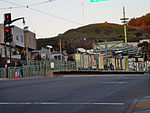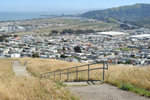Candlestick Park was an outdoor sports and entertainment stadium on the West Coast of the United States, located in San Francisco's Bayview Heights area. The stadium was originally the home of Major League Baseball's San Francisco Giants, who played there from 1960 until moving into Pacific Bell Park (since renamed Oracle Park) in 2000. It was also the home field of the San Francisco 49ers of the National Football League from 1971 through 2013. The 49ers moved to Levi's Stadium in Santa Clara for the 2014 season. The last event held at Candlestick was a concert by Paul McCartney in August 2014, and the demolition of the stadium was completed in September 2015. As of 2019, the site is planned to be redeveloped into office space.The stadium was situated at Candlestick Point on the western shore of San Francisco Bay. Candlestick Point was named for the "candlestick birds" (long-billed curlews) that populated the area for many years. Due to Candlestick Park's location next to the bay, strong winds often swirled down into the stadium, creating unusual playing conditions. At the time of its construction in the late 1950s, the stadium site was one of the few pieces of land available in the city that was suitable for a sports stadium, and had space for the 10,000 parking spaces that had been promised to the Giants.
The surface of the field for most of its existence was natural bluegrass, but for nine seasons, from 1970 to 1978, the stadium had artificial turf. A "sliding pit" configuration, with dirt cut-outs only around the bases, was installed in 1971, primarily to keep the dust down in the breezy conditions. Following the 1978 football season, the playing surface was restored to natural grass.









